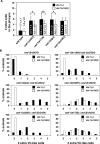Abl kinase inhibits the engulfment of apoptotic [corrected] cells in Caenorhabditis elegans
- PMID: 19402756
- PMCID: PMC2672617
- DOI: 10.1371/journal.pbio.1000099
Abl kinase inhibits the engulfment of apoptotic [corrected] cells in Caenorhabditis elegans
Erratum in
- PLoS Biol. 2009 Jun;7(6). doi: 10.1371/annotation/2259f958-a68e-4e57-92b5-2ef003070cf1
Abstract
The engulfment of apoptotic cells is required for normal metazoan development and tissue remodeling. In Caenorhabditis elegans, two parallel and partially redundant conserved pathways act in cell-corpse engulfment. One pathway includes the adaptor protein CED-2 CrkII and the small GTPase CED-10 Rac, and acts to rearrange the cytoskeleton of the engulfing cell. The other pathway includes the receptor tyrosine kinase CED-1 and might recruit membranes to extend the surface of the engulfing cell. Although many components required for engulfment have been identified, little is known about inhibition of engulfment. The tyrosine kinase Abl regulates the actin cytoskeleton in mammals and Drosophila in multiple ways. For example, Abl inhibits cell migration via phosphorylation of CrkII. We tested whether ABL-1, the C. elegans ortholog of Abl, inhibits the CED-2 CrkII-dependent engulfment of apoptotic cells. Our genetic studies indicate that ABL-1 inhibits apoptotic cell engulfment, but not through CED-2 CrkII, and instead acts in parallel to the two known engulfment pathways. The CED-10 Rac pathway is also required for proper migration of the distal tip cells (DTCs) during the development of the C. elegans gonad. The loss of ABL-1 function partially restores normal DTC migration in the CED-10 Rac pathway mutants. We found that ABI-1 the C. elegans homolog of mammalian Abi (Abl interactor) proteins, is required for engulfment of apoptotic cells and proper DTC migration. Like Abl, Abi proteins are cytoskeletal regulators. ABI-1 acts in parallel to the two known engulfment pathways, likely downstream of ABL-1. ABL-1 and ABI-1 interact physically in vitro. We propose that ABL-1 opposes the engulfment of apoptotic cells by inhibiting ABI-1 via a pathway that is distinct from the two known engulfment pathways.
Conflict of interest statement
Competing interests. The authors have declared that no competing interests exist.
Figures








Comment in
-
Abl is able to inhibit cell engulfment.PLoS Biol. 2009 Apr;7(4):e1000104. doi: 10.1371/journal.pbio.1000104. Epub 2009 Apr 28. PLoS Biol. 2009. PMID: 20076732 Free PMC article. No abstract available.
References
-
- Le Clainche C, Carlier M. Regulation of actin assembly associated with protrusion and adhesion in cell migration. Physiol Rev. 2008;88:489–513. - PubMed
-
- Kedrin D, Rheenen J, Hernandez L, Condeelis J, Segall J. Cell motility and cytoskeletal regulation in invasion and metastasis. J Mammary Gland Biol Neoplasia. 2007;12:143–152. - PubMed
-
- Mangahas P, Zhou Z. Clearance of apoptotic cells in Caenorhabditis elegans . Semin Cell Dev Biol. 2005;16:295–306. - PubMed
-
- Wu YC, Horvitz HR. The C. elegans cell corpse engulfment gene ced-7 encodes a protein similar to ABC transporters. Cell. 1998;93:951–960. - PubMed
Publication types
MeSH terms
Substances
Grants and funding
LinkOut - more resources
Full Text Sources
Other Literature Sources
Molecular Biology Databases
Research Materials
Miscellaneous

